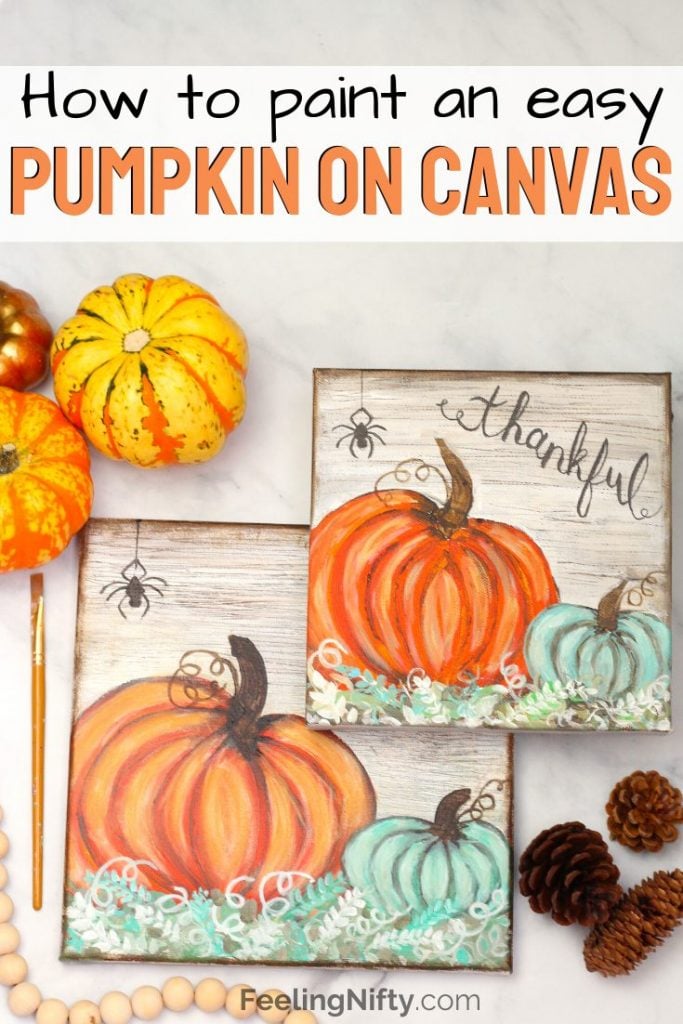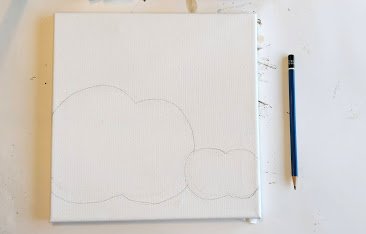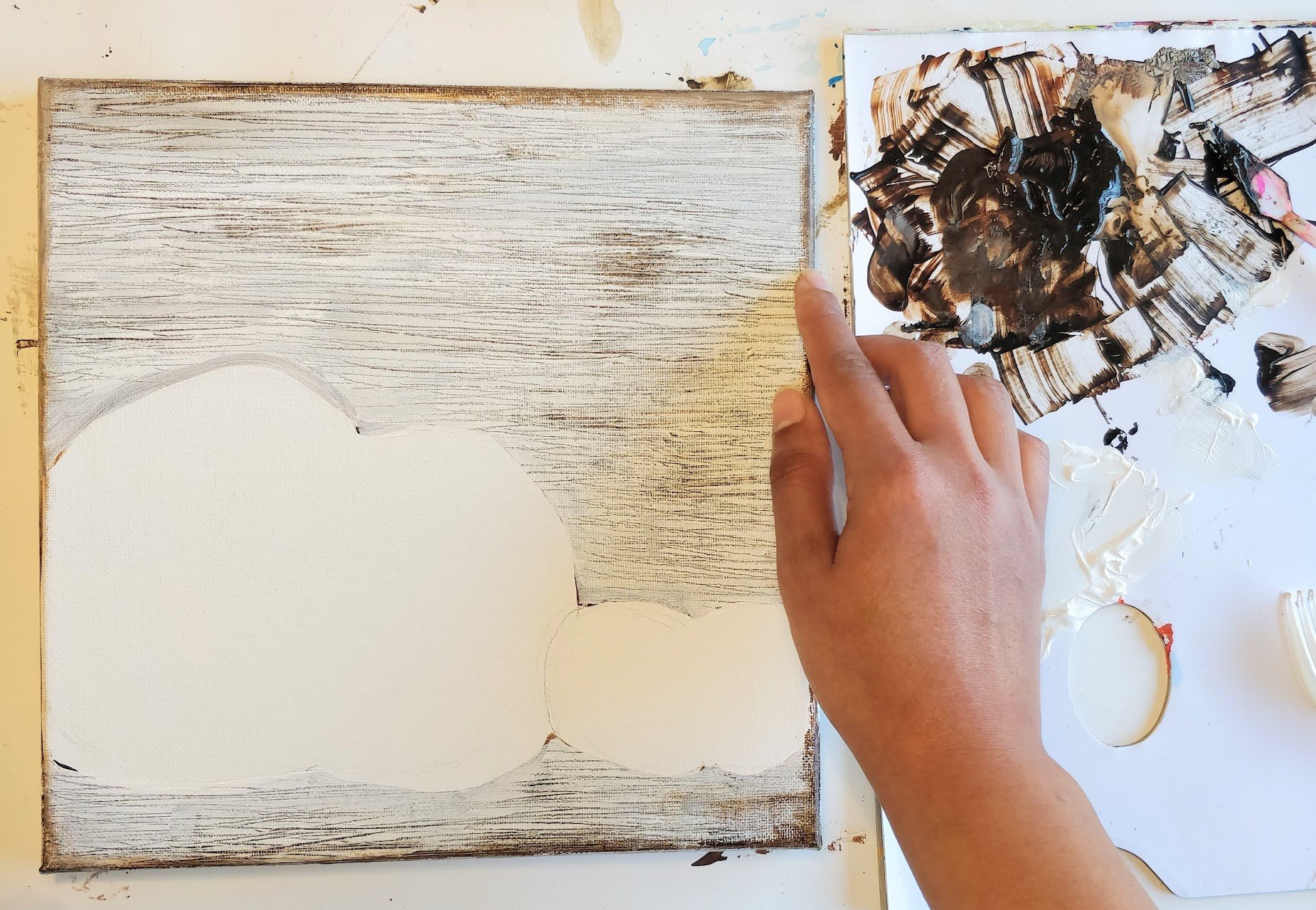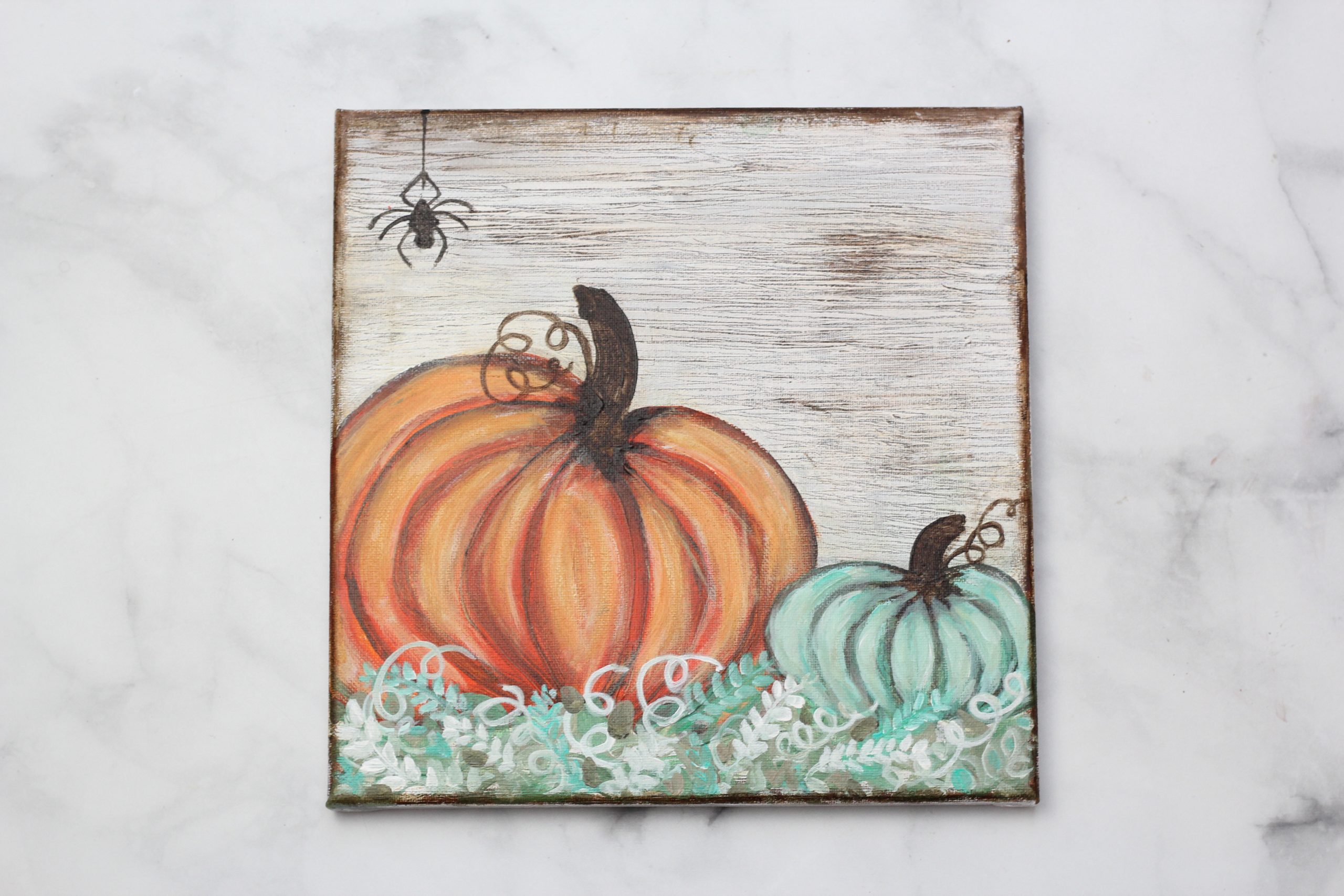How To Paint Pumpkins On Canvas

Fall is my fave! And this fall, I was feeling inspired to paint some lovely orange and teal pumpkins for a cute autumn painting. I've put together a footstep past step tutorial (including a full length video tutorial on YouTube) to evidence you how to paint a pumpkin on canvass, yourself!
This piece of cake fall pumpkin painting is a perfect project for beginners or even older kids! It makes a cute thanksgiving, fall or halloween painting on canvas idea that you tin can decorate your house with too!
The tutorial will prove you lot how to draw a pumpkin on sheet followed past painting a beautiful textured forest background. Finally, you'll learn how to paint a pumpkin on sheet with a double loading brush technique.
Promise you have a gourd time making this painting (haha) ! And be warned, more pumpkin puns to follow….
Oh, and if you love this tutorial, bank check out my acquire to paint series for other fun footstep by step paintings.
How To Draw a Pumpkin on Canvas
How do you describe a pumpkin on canvas?
Easy as pumpkin pie!
The first step is to catch any pencil and depict your pumpkin(s). You tin depict your pumpkins symmetrically, but I like to brand them a bit asymmetrical to make them more interesting. And in reality, many of them are not perfect, which I actually prefer.
Here'due south my sketch with ii pumpkins- one large one (my focal indicate) and one smaller one.

Once you are happy with your pumpkin shapes, y'all can also take you pencil and sketch in the pumpkin ridges. This volition help know how to move your paintbrush when painting them in the steps below.

It's that uncomplicated to depict your pumpkins! Nothing to information technology! And now you are ahead of the cleave! 😀
How To Brand a "Simulated" Wood Background
Making a texturized "faux" wood background is super fun and was my favorite part of this painting! Yes- I love my pumpkins, merely this texture technique really struck a gourd with me. 🙂
I experimented with the different means to make the background look similar a slice of vintage/rustic painted woods.
The technique I ended up choosing doesn't utilize any special mediums or tools that you need purchase. I'thou a big believer on getting artistic with texture and looking around your home for things to use before buying.
For this technique you'll need a fork (plastic or metallic), some night chocolate-brown(burnt umber) and white paint (titanium white).
Faux Chipped Wood Method using a Fork
The first pace is covering your canvas( outside of your pumpkin shapes) with your dark dark-brown pigment. No need to become the strokes to expect perfect, it's going to be covered upwards in the next footstep. I used a 1″ flat wash brush to paint on the brownish.
Leave the chocolate-brown paint to dry fully.

Make sure y'all have some white paint and a fork ready for the side by side pace . Take your 1″ flat wash brush and white pigment (titanium white) and pigment over the brown.

While the white paint is wet (this is key), take your fork and brand horizontal scratch marks across the sail. You lot volition have to work fast in this pace. Every bit a tip, try to make your white paint layer thick, and then the pigment takes longer to dry.

Since the white paint is still moisture, the fork volition make some texturized marks and the brown will show underneath. This volition imitate the texture or wait of forest grain.
When the paint dries information technology volition too feel and look bumpy which brings the background to life!
My biggest tip for this step is to practise it continuing up. You'll take more range of motion. Loosen up, take fun, and do it without thinking too much! The more imperfect and loose/free you lot make the marks, the more character it volition have.
Painting Wood Edges with yous Fingers
After the white pigment is fully dried, it's time to add the finishing footstep to our rustic/vintage "faux" wood. You'll be getting your fingers into the paint and getting a bit messy! It's something that all artists and crafters should try at least one time!
Dip your finger in some of your brownish pigment (not too much just a scrap). You tin can dab your finger on the palette to make certain you lot don't have a huge glob of paint. Now have your finger and smoothen it along all four edges of your canvas.
Enjoy this step and don't aim for perfection. The dazzler in vintage/aged woods is that it's worn, much of the fourth dimension unevenly worn. Paint with that in mind.

Tip: Don't be scared to use your finger and add together some brownish areas on your white background. It will make the fake wood look more "chipped" and anile.
How to Pigment a Pumpkin On Sail with One Stroke Technique
Once you lot've sketched your pumpkins and you've painted your wood background(run into above), you lot're set up to paint your pumpkins!
For this pumpkin painting technique you'll learn a actually fun paintbrush technique called double loading. Simply put, your brush volition take 2 colors on it as the same time (orange and dark-brown). This will assist make the orange "bumps" on the pumpkin with brown shadows that separate each bump in i stroke.
Add together orange paint (cadmium orange hue) and some dark brown pigment (burnt umber) on your palette.
Tip: If your orange/brown paint is very thick, sparse information technology downwards a chip by mixing in a fleck of h2o. This volition make it flow better from the brush.
Using a 1/2" apartment brush (or smaller if your sheet is small), load your castor with orangish paint. Apply a sweeping dorsum and forth motion to load paint. And make sure that the paint is loaded all the manner up the metal ferrule.
Next, dip ane corner of your flat brush in the dark brownish paint. It should wait like the picture below.

With the nighttime brown corner of the brush nearest to the outer edge of the pumpkin, in one stroke pigment a "C" shape (see picture below). Yous'll notice that the brown and orange blend and the brown is focused on the outer border of the pumpkin.
Tip: If you run out of paint half way through the stroke, no worries. Only flip your brush on the other side and paint bottom up towards the middle. You lot desire to make sure that the dark brown corner of the brush is closest to the outer edge of the pumpkin.

We are going to repeat the same "double loading C" stroke for each pumpkin ridge across. The brown will create shadows where the ridges are and so it volition automatically give your pumpkin dimension. And the "C" shape volition give the illusion of curvature across your pumpkin.

Tips on Finishing your Pumpkin
To finish off your pumpkin, here are some boosted tips:
- If you desire darker shadows on each pumpkin bump, you can touch up afterwards. Use your flat brush to pick up some chocolate-brown pigment and go back in and define your shadow lines.
- Employ the pencil marks as a guideline for your paint strokes,. It will make it easier to know how round to make your "C" shapes.
- Repeat the aforementioned "C" strokes on the contrary side of your pumpkin until both sides join in the middle. The middle of the pumpkin should wait like a sideways ellipse shape.
- Don't worry about perfecting the bottom edge of the pumpkin, it'll be covered with leaf in the later on steps.

Pumpkin Highlights & Stalk
Once your pumpkin pigment is dried, yous are going to go back in with some lighter colors and highlight it. This will really bring your pumpkin to life!
Beginning, take your orange pigment and create 2 piles. Mix a flake of white paint into each piles. Make sure one of your piles is a lighter orange and one is slightly darker orange.
We are going to use a "dry brush" technique to apply the highlights. For the technique to work yous will demand to brand certain your brush is completely dry out. Apply a paper towel to dry your brush so in that location isn't any moisture on it.
Adjacent, dip your brush(aforementioned i/2″ flat brush we used for the pumpkin above) into the darker of the 2 orange piles (just a picayune flake of pigment). Using your brush paint a few highlights on each pumpkin "C" stroke on your pumpkin.
Next, have your lightest orange color and add more highlights to each "C" pumpkin stroke. Yet, this time don't add equally many highlights. To assistance visualize where focus these highlights, imagine a lite shinning from the top corner of your canvas down onto your pumpkins. Endeavour to imagine where the light would hit on your pumpkin, and add together your highlights there.

Next you volition employ your flat brush and pigment in a stem with your same dark brown pigment. I used a 1/4″ flat castor since the stem isn't very wide (merely feel free to use what ever brushes you already accept). If you desire to add in a curly co-operative to the stem, you can use a size 0 round brush ( or any modest circular castor you tin have). Yous'll likewise desire to thin down your nighttime brown paint with h2o so that it'southward easier for the pigment to flow from the brush. Information technology should be the consistency of a thick ink.
You lot can echo the aforementioned steps as above for the smaller pumpkin. I decided to make the smaller pumpkin with a teal/ aqua dark-green color. Merely you tin can choose whatever color you'd like!

How to Paint a Pumpkin On Sheet – Fourth dimension Lapse
Active Time 1 hour
Total Time i 60 minutes
Difficulty Beginner
Estimated Cost $ten
Materials
- Cadmium Orange Hue
- Burnt Umber
- Titanium White
- Mars Black
- Aqua Dark-green
- Light Light-green Permanent (optional)
- Plastic cutlery fork
- one" apartment brush
- 1/ii" flat brush
- Liner brush
Instructions
- To scout the full length pace by step video tutorial, you lot can watch on youtube.
- Draw your pumpkin shapes onto you lot sheet.

- Use the directions above for creating the "simulated wood" background.

- Now time to paint some orange pumpkins! Using your cadmium orangish hue and burnt umber colors, follow the steps in the department higher up to paint your orangish pumpkin. Commencement you'll fill in the pumpkin with the double loading i stroke technique, then use highlights to you pumpkin, and finally add together the stem and a curly tendril.

- Follow the same steps as in a higher place for your teal pumpkin, but instead of orangish utilize aqua light-green paint.

- Once the pumpkins are done, employ your liner brush and some mars black pigment to draw on your spider hanging down from a web. Think of your spider in terms of simple shapes: a diamond shaped body, a circle caput and eight long legs 🙂 Tip: thin out your black paint quite a bit with water before loading it onto your liner brush (like a thick ink consistency). This will make the brush strokes and lines smoother and more crisp.

- The last step is to add together some pretty foliage and leaves at beneath the pumpkins. Take your burnt umber, white, aqua green and another green pigment of your choice. Using these 4 colors create a few unlike hues. This is a great do to become you enjoying pigment mixing and seeing what interesting colors you lot tin create. You can't go wrong hither, so enjoy! These colors will work well together to create some prissy earthy tones. Apply a variety of brushes of your choice to brand interesting leaves, branches, etc with the colors your created. It will look very 1 dimension and flat at this stage, not to worry- we volition bring information technology to life in the next step!


- Once you have filled in the lesser with your folliage. Take some titanium white mixed with the tinniest bit of whatever green. This will create a pale, near white color. Thin the paint with water (thick ink consistency) and then it flows easier from the brush. Create some more than "highlight" folliage with this paint color and a size 0 round brush. This step will add beautiful dimension to the bottom of your painting. I added some interesting curly branches and other leaves similar "wheat ears", but feel free to apply your imagination.

- Optional:Feel gratuitous to add some handwritten inspiring words or text to the top correct hand corner of your painting. I made 2 paintings to show yous the difference (1 with wording, i without). To get the placement just right, I outset used a pencil to trace in my wording onto the canvas, then went over information technology with some black paint and a liner brush. Alternatively y'all can used a black Sharpie for more control.


Recommended Products
As an Amazon Associate and fellow member of other affiliate programs, I earn from qualifying purchases.
-

Winsor & Newton Cotman Water Colour Series 111 Short Handle Synthetic Castor - Circular #0
-

Strathmore 365-ix 300 Series Palette Pad, 9"x12" Record Bound, forty Sheets
-

PHOENIX White Blank Cotton Stretched Canvas Artist Painting - 8x8 Inch / 7 Pack - 5/8 Inch Profile Triple Primed for Oil & Acrylic Paints
-

Princeton Velvetouch Artiste, Mixed-Media Brush for Acrylic, Watercolor & Oil, Series 3950 Wash Luxury Synthetic, Size i/2
-

Santa Fe Art Supply Best Quality Artist Paintbrush Flat Wide 1 Inch. Acrylic Oil Watercolor & Face Paint. Long Handle Replacement Pigment Brushes with
-

Liquitex BASICS Acrylic Paint, 4-oz tube, Lite Green Permanent
-

Liquitex Basics Acrylic Pigment, eight.45-oz tube, Bright Aqua Green, 8 Fl
-

Liquitex Basics Acrylic Paint, 4-oz tube, Mars Blackness
-

Liquitex Nuts Acrylic Pigment, eight.45-Oz Tube, Titanium White
-

Liquitex 4385720 Basics Acrylic Paint, 8.45-oz tube, Cadmium Orange Hue
-

Liquitex Basics Acrylic Paint, four-oz tube, Burnt Umber





Bask friends, and hope you cleave out some time to make this fun fall pumpkin art!
xoxo,
Jasmine
If you liked this tutorial, please pin information technology!

Source: https://feelingnifty.com/how-to-paint-a-pumpkin-on-canvas-beginner/



0 Response to "How To Paint Pumpkins On Canvas"
Post a Comment